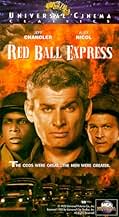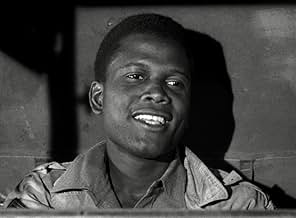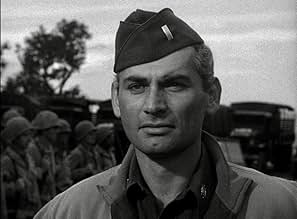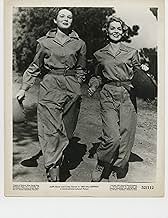NOTE IMDb
6,3/10
1 k
MA NOTE
Ajouter une intrigue dans votre langueStory of the military truck drivers who kept the Allied armies supplied in Europe during World War II.Story of the military truck drivers who kept the Allied armies supplied in Europe during World War II.Story of the military truck drivers who kept the Allied armies supplied in Europe during World War II.
- Réalisation
- Scénario
- Casting principal
Davis Roberts
- Pvt. Dave McCord
- (as Robert Davis)
Gregg Palmer
- Tank Lieutenant
- (as Palmer Lee)
Douglas Bank
- Mechanic
- (non crédité)
George Barrows
- Soldier in Bistro
- (non crédité)
Nan Boardman
- French Peasant Mother
- (non crédité)
Avis à la une
There is more to war than just the glory boys; 95% of the GIs in WW 2 (and all other wars) are never in the limelight as heroes, but they did more than their fair share of sacrifice. My father was one of those guys. He landed at Normandy, was with the infantry marching to the Hurtgen Forest, and getting overrun in the Battle of the Bulge. He was there for it all. He might not have been a hero in those battles (he was always looking for dry socks), but he was a hero to me. He and thousands of others, such as the men in The Red Ball Express, doing thankless jobs and sacrificing a lot more than just a few days lost sleep. Try driving 30 hours without sleep sometime. An underrated film, very similar to The Sorcerer, and the French film, Wages of Fear, but a bit more traditional. Good viewing.
The setup, in case you don't already know it, is this. The troops of the western Allies were bottle necked in Normandy, France, for the first month or so after the D-Day landings. The armies finally broke through the German defenses and Gen. George Patton's Third Army rapidly advanced across central and northern France. So rapidly that they outpaced their supply lines. The U.S. Army put together a truck convoy system to keep Patton's forces supplied and named it the Red Ball Express. Aside from managing to keep up with Patton's advance, the outfit is also noted for being one of the few integrated units in the U.S. armed forces at the time--I use the term "integrated" somewhat guardedly, since that usually meant white senior officers leading black junior officers and enlisted men, which is not what would first come to my mind as "integrated." Regardless, around 75% of the servicemen in the Red Ball Express were African Americans.
You wouldn't know that from this movie, where the ratio seems to have been reversed. However, I'm willing to give the filmmakers some credit for at least trying to address the integration issue at the time when they were working rather than castigate them for not doing what we might expect a present-moment filmmaker to do. That's not the real problem with this movie as a movie. Acting is not the problem with this movie, either, as another reviewer suggested. The acting is workmanlike--neither outstanding nor poor, just efficient. No, the weakness of this movie is that it is simply another cliché-ridden war movie; blame not the messengers, but rather the script. First, there is the clichéd unit. Our two lead characters have a troubled past and, surprise surprise, are forced to work together in the same outfit ("of all the gin joints in all the towns . .."). The unit has a romantic, it has a "runt" of the litter with glasses, it has a stolid misunderstood commander, it has a guy clearly from Brooklyn, and so forth. Just like any other war movie of the day (think of, say, "Air Force" or "Guadalcanal Diary"). What's new here for the time is that the filmmakers exchanged African Americans for some of the other stereotypical roster of "average Americans" you got in any war movie. Notably, there are NO characters who are clearly supposed to be white Southerners--an omission that itself speaks volumes about how sensitive race relations were in the early 1950s in the U.S. and especially in the then-recently desegregated U.S. armed forces.
The clichéd unit is indicative of the rest of the flick. You've seen this movie before. Bunch of misfits forced to work together overcome their differences and become a cohesive fighting unit--well, except here I never really got the sense we were watching an outfit of misfits. Yes, there's the guy with the racial issue vs. Sidney Poitier, and yes, there's the lead characters with the troubled past--one of whom is the main stumbling block that's keeping this outfit from fully coming together (what's that you say? That setup sounds like "Flying Tigers"? no wait, "Sands of Iwo Jima"? no, wait . . .)--but the movie is in too much of hurry to get this outfit on the road to really *show* how this outfit becomes a team. Essentially it just is. What else, you ask? How about the sweet-talking American and the saucy French girl? Rivalry with another outfit, with other outfit finally recognizing our heroes are indeed Heroes? The guys who think there mission is going to be a cakewalk only to discover the Harsh Reality Of War? Etc., etc.
Oh, the movie is solid enough and hits all the standard points--some action, some down time, some roughhousing, a romantic moment or two, some grousing, some "let's pull together" time--and some of the cast members are likable enough that, all told, you won't feel like you wasted your time watching this one. However, aside from the then-timely touch of trying to show an integrated outfit there's nothing here to see you haven't seen before.
You wouldn't know that from this movie, where the ratio seems to have been reversed. However, I'm willing to give the filmmakers some credit for at least trying to address the integration issue at the time when they were working rather than castigate them for not doing what we might expect a present-moment filmmaker to do. That's not the real problem with this movie as a movie. Acting is not the problem with this movie, either, as another reviewer suggested. The acting is workmanlike--neither outstanding nor poor, just efficient. No, the weakness of this movie is that it is simply another cliché-ridden war movie; blame not the messengers, but rather the script. First, there is the clichéd unit. Our two lead characters have a troubled past and, surprise surprise, are forced to work together in the same outfit ("of all the gin joints in all the towns . .."). The unit has a romantic, it has a "runt" of the litter with glasses, it has a stolid misunderstood commander, it has a guy clearly from Brooklyn, and so forth. Just like any other war movie of the day (think of, say, "Air Force" or "Guadalcanal Diary"). What's new here for the time is that the filmmakers exchanged African Americans for some of the other stereotypical roster of "average Americans" you got in any war movie. Notably, there are NO characters who are clearly supposed to be white Southerners--an omission that itself speaks volumes about how sensitive race relations were in the early 1950s in the U.S. and especially in the then-recently desegregated U.S. armed forces.
The clichéd unit is indicative of the rest of the flick. You've seen this movie before. Bunch of misfits forced to work together overcome their differences and become a cohesive fighting unit--well, except here I never really got the sense we were watching an outfit of misfits. Yes, there's the guy with the racial issue vs. Sidney Poitier, and yes, there's the lead characters with the troubled past--one of whom is the main stumbling block that's keeping this outfit from fully coming together (what's that you say? That setup sounds like "Flying Tigers"? no wait, "Sands of Iwo Jima"? no, wait . . .)--but the movie is in too much of hurry to get this outfit on the road to really *show* how this outfit becomes a team. Essentially it just is. What else, you ask? How about the sweet-talking American and the saucy French girl? Rivalry with another outfit, with other outfit finally recognizing our heroes are indeed Heroes? The guys who think there mission is going to be a cakewalk only to discover the Harsh Reality Of War? Etc., etc.
Oh, the movie is solid enough and hits all the standard points--some action, some down time, some roughhousing, a romantic moment or two, some grousing, some "let's pull together" time--and some of the cast members are likable enough that, all told, you won't feel like you wasted your time watching this one. However, aside from the then-timely touch of trying to show an integrated outfit there's nothing here to see you haven't seen before.
This is obviously a war film that will never be dated. Even after 60 years, it is fresh and relevant, because it tells about life the way it was in World War II, as experienced by people of the era, in a way that is credible.
We get a good mix of the "workmanship" of war, combined with "down time" and "deadly time". Chandler plays the officer who realizes how dangerous it is to be "lax", as one might be when 98% of your duty is simply workmanship, like driving, loading, and unloading supply trucks. It is the "unforeseeen" incident that gets you. It is being unready. It is the fluke or freak occurrence that will be deadly.
We have a star studded cast here, fairly common for old war films, but impossible for the twenty-first century, simply because of the dilution of movie making. Not that "dilution" is bad, but it's simply the fact that if everyone and his cousin is making a movie, then there are millions of actors, and thus no way for more than a few dozen to ever gain the sort of fame that hundreds of actors used to have.
The integration was splendid in this film, and believable. The white and black troopers behaved and spoke in a way that made you think they were from the mid twentieth century.
This is hard to do today. It is done today, but it is hard to sell that concept today. However, one must remember one thing in making World War II movies. If one makes it for the lingo of the era, as this film does, then it always remains true and credible. If one makes it for the lingo of 1990 or 2000, it will get a huge following for that generation, but in 80 years, it will be scoffed at by later generations, while films like "Red Ball Express" continue to stick around.
The acting is great, and the characters are great. Each character brings his own story to the screen, so we have many subplots. There are 3 major ones, each involving the major stars.
The subplots are handled well, and while the one with Chandler and Nicol is over the top, it is dramatic and theatrical, and well handled.
Chandler was the big star at the time. O'Brien is a minor mainstay, somehow always remaining a recognizable individual that is rare for leading man types. Poitier is a legend, with "Lillies", "Heat", "Dinner", and "Bedford" insuring his status. Drake will always remain a mainstay as a player of lovable rogues. This may be his best role, as he pretty much steals the show. Alex Nicol is the wild card. Films like this, "Then There Were Three", and "The Man From Laramie" will go back and forth to and from classic status, and he will be a huge name in classic film a hundred years from now. He probably never realized this while he was making "B" budget movies.
We get a good mix of the "workmanship" of war, combined with "down time" and "deadly time". Chandler plays the officer who realizes how dangerous it is to be "lax", as one might be when 98% of your duty is simply workmanship, like driving, loading, and unloading supply trucks. It is the "unforeseeen" incident that gets you. It is being unready. It is the fluke or freak occurrence that will be deadly.
We have a star studded cast here, fairly common for old war films, but impossible for the twenty-first century, simply because of the dilution of movie making. Not that "dilution" is bad, but it's simply the fact that if everyone and his cousin is making a movie, then there are millions of actors, and thus no way for more than a few dozen to ever gain the sort of fame that hundreds of actors used to have.
The integration was splendid in this film, and believable. The white and black troopers behaved and spoke in a way that made you think they were from the mid twentieth century.
This is hard to do today. It is done today, but it is hard to sell that concept today. However, one must remember one thing in making World War II movies. If one makes it for the lingo of the era, as this film does, then it always remains true and credible. If one makes it for the lingo of 1990 or 2000, it will get a huge following for that generation, but in 80 years, it will be scoffed at by later generations, while films like "Red Ball Express" continue to stick around.
The acting is great, and the characters are great. Each character brings his own story to the screen, so we have many subplots. There are 3 major ones, each involving the major stars.
The subplots are handled well, and while the one with Chandler and Nicol is over the top, it is dramatic and theatrical, and well handled.
Chandler was the big star at the time. O'Brien is a minor mainstay, somehow always remaining a recognizable individual that is rare for leading man types. Poitier is a legend, with "Lillies", "Heat", "Dinner", and "Bedford" insuring his status. Drake will always remain a mainstay as a player of lovable rogues. This may be his best role, as he pretty much steals the show. Alex Nicol is the wild card. Films like this, "Then There Were Three", and "The Man From Laramie" will go back and forth to and from classic status, and he will be a huge name in classic film a hundred years from now. He probably never realized this while he was making "B" budget movies.
It's a sad commentary that before the Armed Services were integrated post World War II by President Truman, the Red Ball Express was one of the few that black American soldiers could fully participate in and that one was relatively behind the lines.
Jeff Chandler plays the steely eyed commander of this bunch of formerly civilian truck drivers now chosen as a unit to supply Patton's advancing army with needed fuel. Among the cast is a young Sidney Poitier as one of the drivers. They may have been behind the lines, but the picture clearly shows their participation in the war wasn't an easy street.
Chandler's job is to weld this disparate bunch into a unit and he succeeds despite a lot of racial tension. The cast performs admirably in this picture.
One of the great stories of World War II was the rapid advance across France of Patton's army after the breakout from the Normandy beachhead. He could have never done it without the heroic efforts of the men depicted in this movie. It was Ike's and Patton's secret weapon and this picture an admirable tribute to them.
Jeff Chandler plays the steely eyed commander of this bunch of formerly civilian truck drivers now chosen as a unit to supply Patton's advancing army with needed fuel. Among the cast is a young Sidney Poitier as one of the drivers. They may have been behind the lines, but the picture clearly shows their participation in the war wasn't an easy street.
Chandler's job is to weld this disparate bunch into a unit and he succeeds despite a lot of racial tension. The cast performs admirably in this picture.
One of the great stories of World War II was the rapid advance across France of Patton's army after the breakout from the Normandy beachhead. He could have never done it without the heroic efforts of the men depicted in this movie. It was Ike's and Patton's secret weapon and this picture an admirable tribute to them.
This is not my favourite from Budd Boetticher, not his best either, just a common war flick, but speaking of something rather important for US Army just after D Day for logistics matters, because all the French railway nets were destroyed. It had to be told about, I guess not other film did it. That said the cast is OK, with a convincing Jeff Chandler but not as good as in MERRIL'S MARAUDERS for instance. The real Red Ball Express took many Black soldiers who could not fight in regular troops because of racial segregation in US Army during this period. Yes, this story had to be told, but I guess many things, details have been changed from reality.
Le saviez-vous
- AnecdotesLouis L'Amour's memoir, "Education of a Wandering Man", said this movie was actually based on his own war-time anecdotes. He was awarded two Bronze Star Medals while serving as an officer with the Red Ball Express.
- GaffesThe real Red Ball Express operated two separate roads for traffic (one going to the front and one for returning empty) Two-way traffic on a single road, as shown in the film , never occurred.
- Crédits fousNo credits besides the title, seven minutes in the film.
- ConnexionsFeatured in Budd Boetticher: A Man Can Do That (2005)
Meilleurs choix
Connectez-vous pour évaluer et suivre la liste de favoris afin de recevoir des recommandations personnalisées
- How long is Red Ball Express?Alimenté par Alexa
Détails
- Durée1 heure 23 minutes
- Couleur
- Rapport de forme
- 1.37 : 1
Contribuer à cette page
Suggérer une modification ou ajouter du contenu manquant

Lacune principale
By what name was Les conducteurs du diable (1952) officially released in India in English?
Répondre



































